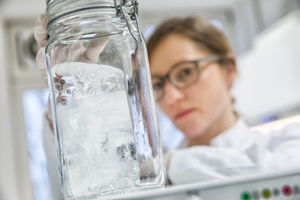MICROPLASTICS
Polar researchers measure record microbeads concentrations in Arctic sea ice / Local marine pollution from shipping confirmed for the first time
 High concentrations of microplastics have been found in Arctic ice cores (Photo: AWI/Tristan Vankann) |
For a number of years now, the water in the Arctic Ocean has been polluted through the inflow of plastics waste from other oceans as well as waste that is increasingly of local origin, such as from fishing vessels. This has recently been confirmed by researchers at the Alfred Wegener Institute, Helmholtz Centre for Polar and Marine Research (AWI, Bremerhaven / Germany; www.awi.de) following a study on Arctic ice cores. According to the researchers, the amounts of microplastics are higher than ever. Specimens taken from five different regions of the Arctic Ocean in 2014 and 2015 contained more than 12,000 microplastic particles per litre of sea ice in some cases – two to three times more than in previous measurements. The work was published in the journal Nature Communications (www.nature.com/ncomms).
The scientists were able to trace the origins of the plastic particles, which were between 11 µm and 5 mm in size. They are assumed to come from garbage patches in the Pacific Ocean due to the high concentration of polyethylene and polypropylene particles, which are "above all used in packaging." At the same time, high percentages of paint and polyamide particles from ships' paint and fishing nets point to the increasing level of shipping and fishing activities in parts of the Arctic Ocean.
"Troubling" is how AWI biologist Ilka Peeken refers to the observation, but also adds that so far no one "can say for certain how harmful these tiny plastic particles are for marine life, or ultimately also for human beings." They do, however, constitute a danger for creatures that are filter feeders, such as the blue whale that lives off plankton.
In total, the scientists found 17 different types of plastic in the sea ice, including polyethylene and polypropylene, but also paints, polyamide, polyester and cellulose acetate. Together, these six materials accounted for roughly half of all the microplastic particles detected.
The sea ice binds microplastics for two to eleven years. This is the time it takes for ice floes from the seas of Siberia or the North American Arctic to reach and melt in Fram Strait – a shipping route between Spitzbergen / Norway and Nordostrundingen in the north east of Greenland. It is still not clear where the plastic particles that are released actually go. "Free-floating microplastic particles are often colonised by bacteria and algae, which makes them heavier and heavier," says AWI scientist Melanie Bergmann. They could form clumps with algae and sink into deeper waters. Microplastics concentrations of up to 6,500 plastic particles per kilogram of seafloor were recently recorded there.
e-Service:
"Arctic sea ice is an important temporal sink and means of transport for microplastic" (April 2018) as a PDF file
The scientists were able to trace the origins of the plastic particles, which were between 11 µm and 5 mm in size. They are assumed to come from garbage patches in the Pacific Ocean due to the high concentration of polyethylene and polypropylene particles, which are "above all used in packaging." At the same time, high percentages of paint and polyamide particles from ships' paint and fishing nets point to the increasing level of shipping and fishing activities in parts of the Arctic Ocean.
"Troubling" is how AWI biologist Ilka Peeken refers to the observation, but also adds that so far no one "can say for certain how harmful these tiny plastic particles are for marine life, or ultimately also for human beings." They do, however, constitute a danger for creatures that are filter feeders, such as the blue whale that lives off plankton.
In total, the scientists found 17 different types of plastic in the sea ice, including polyethylene and polypropylene, but also paints, polyamide, polyester and cellulose acetate. Together, these six materials accounted for roughly half of all the microplastic particles detected.
The sea ice binds microplastics for two to eleven years. This is the time it takes for ice floes from the seas of Siberia or the North American Arctic to reach and melt in Fram Strait – a shipping route between Spitzbergen / Norway and Nordostrundingen in the north east of Greenland. It is still not clear where the plastic particles that are released actually go. "Free-floating microplastic particles are often colonised by bacteria and algae, which makes them heavier and heavier," says AWI scientist Melanie Bergmann. They could form clumps with algae and sink into deeper waters. Microplastics concentrations of up to 6,500 plastic particles per kilogram of seafloor were recently recorded there.
e-Service:
"Arctic sea ice is an important temporal sink and means of transport for microplastic" (April 2018) as a PDF file
02.05.2018 Plasteurope.com [239618-0]
Published on 02.05.2018

 German version of this article...
German version of this article...